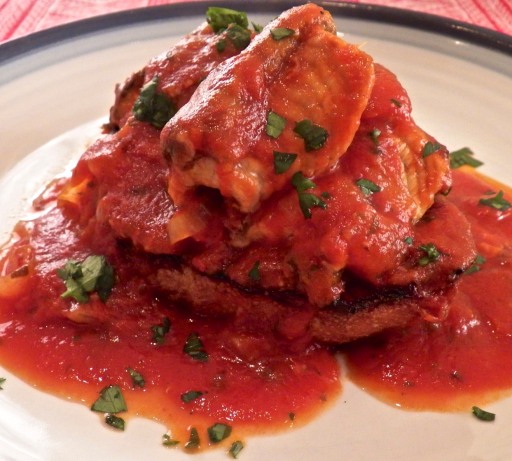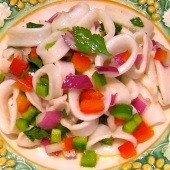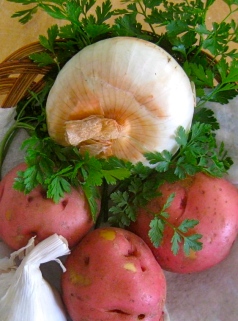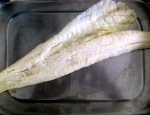Linguine al Nero di Calamari con Vongole e Bottarga

(With thanks to the folks at Colored Mondays)
We Bartolini are an ecumenical lot. Whether you celebrate Hanukkah, Kwanzaa, Christmas, or even Festivus, we hope your holidays are of the most memorable kind.
* * *
Although this is my 4th Christmas Eve on WordPress (I know! FOURTH!?!?!), this is the 3rd time I’ve used the occasion to highlight seafood. In the past, I shared a tongue-in-cheek tale of how Italian Catholics prepared a Feast of the Seven Fishes to get around the Church’s rule of not eating meat on Christmas Eve. To be sure, the Church’s original intent was to keep that day, the last of Advent, a day of refection and sacrifice in preparation for the Christ Child’s imminent arrival. Some of the faithful, however, couldn’t wait to get the party started, so, instead they prepared a seafood feast. To avoid the Church’s wrath, they prepared 7 different dishes, 1 fish for each of the Seven Holy Sacraments. With their Church leaders appeased — many of whom were enjoying their own, even more lavish, seafood feasts — a tradition was born. Today, feasts of 10, 11, and even 12 seafood dishes may be prepared and served.
Last week I shared my family’s recipe for garbanzo soup, the type of simple dish that I’m sure the Church had originally intended Catholics prepare on the last day of Advent. Today I’ll share a recipe that is far removed from last week’s simple, unadorned minestra, Squid Ink Pasta with Clams and Bottarga. I’ll get to the recipe soon enough but 1st, I’ve “got some ‘splaining to do.”
* * *

* * *
I think it was Mom who told me about Nonna (Zia’s Mother-in-law) cleaning cuttlefish, sepia. A cousin of squid, sepia are often prepared in very much the same ways. (Those who have owned parakeets, “budgies”, often hang cuttle bones in their cages to be used by the birds for beak maintenance. These “bones’ are removed from large cuttlefish during cleaning.) Nonna’s sepia were quite fresh and had to be gutted and cleaned. As I recall, if she was lucky enough to come upon a sepia’s ink sack, Nonna reserved it and used it to make black pasta noodles.
The story stuck with me and, over the years, I’ve searched high and low for the illusive ink. I wasn’t picky. It didn’t matter whether I found squid or sepia ink. As my search criss-crossed Chicago’s ethnic neighborhoods, I cannot tell you how many dead ends I reached, having followed the advice of some well-meaning people who were sure that it could be found at this place or that. Dejected, I’d give up the search, only to begin it anew when some TV chef used squid ink to make pasta. Once, last year, I even purchased ready-made black pasta noodles. What a disappointment!
This all changed about 3 months ago. Armed with a gift card given to me by Cynthia and Nigel for my last birthday, I went shopping at Chicago’s newest Italian market. (Cynthia  and Nigel are the friends with whom I shared the flats in Florence and Rome.) As I passed the fresh pasta counter, I noticed they were selling black pasta. Upon asking, the clerk directed me to the fishmongers and, lo and behold, they had squid ink! Not only that but they had 2 kinds: 1, a large jar of thick paste, and, the other, a much thinner liquid, in packaging that would remind you of those ubiquitous soy sauce packets found at the bottom of every bag of Chinese take-away. After the fishmonger assured me that it would “last forever”, I bought the paste, thinking I could better control the amount used. On the way home, I decided that this would be the dish I would serve Zia for our Christmas dinner.
and Nigel are the friends with whom I shared the flats in Florence and Rome.) As I passed the fresh pasta counter, I noticed they were selling black pasta. Upon asking, the clerk directed me to the fishmongers and, lo and behold, they had squid ink! Not only that but they had 2 kinds: 1, a large jar of thick paste, and, the other, a much thinner liquid, in packaging that would remind you of those ubiquitous soy sauce packets found at the bottom of every bag of Chinese take-away. After the fishmonger assured me that it would “last forever”, I bought the paste, thinking I could better control the amount used. On the way home, I decided that this would be the dish I would serve Zia for our Christmas dinner.
What I haven’t mentioned is that, months before, I had ordered some bottarga online, intending to serve it to Zia some day. Bottarga is the dried and cured eggs of mullet fish. Thought to have Greek or Arabic origins, bottarga is a Mediterranean product and can be found from Portugal and Spain to North Africa. In Italy, it is most closely identified with Sardinia and Sicily, while here in the States, bottarga is now produced in Florida. (If  interested, “locally” produced Bottarga is usually available this time of year.) Bottarga can be bought dried in the original egg sacks, or sealed in wax, or both. Once purchased, if kept dry, it will last quite some time in the fridge. While its scent has been described as the “breath of the sea”, bottarga is bursting with umami, lending both salty and fishy flavors to your dish. To serve, some may shave thin slices which are then used to top off bruschetta or salads. Using a microplane or similar utensil, others will grate bottarga over pasta, risotto, grilled vegetables, broiled/baked/grilled fish, and even eggs. There is one thing about bottarga, though, that you should consider before rushing off to purchase some. Not everyone likes the stuff. Very much like anchovies, you either love it or hate it. Lucky for us, we all love it.
interested, “locally” produced Bottarga is usually available this time of year.) Bottarga can be bought dried in the original egg sacks, or sealed in wax, or both. Once purchased, if kept dry, it will last quite some time in the fridge. While its scent has been described as the “breath of the sea”, bottarga is bursting with umami, lending both salty and fishy flavors to your dish. To serve, some may shave thin slices which are then used to top off bruschetta or salads. Using a microplane or similar utensil, others will grate bottarga over pasta, risotto, grilled vegetables, broiled/baked/grilled fish, and even eggs. There is one thing about bottarga, though, that you should consider before rushing off to purchase some. Not everyone likes the stuff. Very much like anchovies, you either love it or hate it. Lucky for us, we all love it.
It took no time to decide what would be the 3rd and final ingredient for our Christmas Eve pasta. Both Zia and I love pasta with clams, vongole. Now, I always go to the Italian markets the day before I depart for Zia’s, buying her a few Italian staples that just aren’t available in her area. In the past, if the fishmonger has fresh clams — especially vongole from Italy — I’ll buy some, pack them in ice, and warn Zia that clams will be on the menu. That’s what I did just prior to my last visit, though the clams were the manila variety. I left the next day knowing that there was a great dinner in our immediate future.
I served this pasta to Zia as our early Christmas Dinner. It was a complete surprise to her and to her son, my cousin the Max Whisperer, who was also seated at the table. Both thoroughly enjoyed the dish, as will you and your guests when you serve it.
* * *

* * *
To make squid ink pasta
It is far easier to make black pasta than you might assume. Gather the ingredients required to make a batch of Mom’s Pasta Dough. Once you’ve placed 4 whole eggs + enough water to equal 1 cup of liquid in a measuring cup, add 1½ tbsp of squid ink. Lightly beat the mixture to fully incorporate the ink. (See Notes) Proceed as your would when making normal pasta dough, cutting it, once dry, to make whichever sized noodles you prefer. (I made trenette because it most closely resembles the pasta that Mom would cut by hand.) Cook as you would normal pasta, removing it from the water just before reaching al dente. Reserve a cup of pasta water.
* * *
* * *
To prepare the clams
(See Notes for help with cleaning clams)
Heat 1/4 cup olive oil over medium-high heat in a large fry pan with cover. Once hot, add 2 cloves minced garlic and sauté for about a minute. Add 1/4 cup water, 1/4 cup white wine, and about 3 dozen vongole. (Cockles, little neck, or manilla clams may be substituted.) Cover the pan and allow the clams to open, about 5 to 8 minutes. Do not overcook and discard any clams that have not opened by the end of the cooking time. Add about 3 tbsp of chopped fresh parsley.
* * *
To assemble the dish and serve
Once the unopened clams have been removed, place the newly drained pasta into the fry pan and toss to coat with the clams and pan juices. Add a little of the reserved pasta water if needed. Pour the pan’s contents on to a serving platter. Drizzle a little of your best extra virgin olive oil on top of the pasta, followed by some chopped parsley. Grate, as you would a garnish, a bit of bottarga on top of the pasta and serve. Once your guests have received their serving, be sure that each receives another sprinkling of bottarga, whether you do the grating or they handle it themselves.
* * *

* * *
Notes
Blending the squid ink with the eggs ensures that it will be evenly dispersed throughout the pasta dough much more quickly than if added directly to the flour.
If, when handling the dough, your notice your fingers or work surface blackening, it’s a sign that your dough needs a bit more flour. Perfectly mixed flour will not “bleed” black.
Clams must be inspected and cleaned before use.
- Examine your clams, discarding any with cracked or broken shells. Also, discard any that are open, even slightly, and that will not close when tapped on a counter top.
- Clams bought at most markets today usually have been purged of sand prior to purchase. You must purge the clams if you harvest them yourself or buy them directly from the fishermen. To purge the clams of sand, place them in a deep bowl and cover with room temperature water. Soak for 30 minutes, empty the water and, repeat the process at least another time.
- Once purged, use a small brush to scrub the shells. Again, discard any that remain open — even a wee bit — during the scrubbing process.
- Clams are now ready for cooking.
The Italian custom of avoiding cheese with most seafood pastas is not some “silly” or “ridiculous” decree. The suggestion is based on the fact that many forms of seafood are quite mildly flavored. Use of Pecorino Romano or Parmigiano Reggiano would easily overpower the seafood, rendering it almost “invisible” to the palate. In today’s recipe, cheese would most certainly mask the delicate flavors of the squid ink pasta and clams, as well as obliterate all of the bottarga’s scent and much of its flavor. Of course, you can eat whatever you like but if you take the time to seek out and purchase fresh seafood, often at premium prices, why hide it under a blanket of cheese?
* * *
It’s déjà vu all over again …

It was but a year ago when I shared another seafood dish worthy of any Christmas Eve celebration. In that dish, clams, mussels, shrimp, calamari, and scallops were combined with linguine in a mildly spiced tomato sauce and sealed in parchment before being baked. It is a very special dish for a very special night. You can learn how to prepare it by clicking HERE.
* * *
Coming soon to a monitor near you …

Eggs in Purgatory
* * *
Buon Natale a Tutti!
* * *










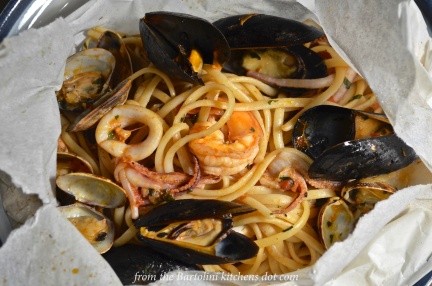
 Stovetop Braised Rabbit
Stovetop Braised Rabbit


































